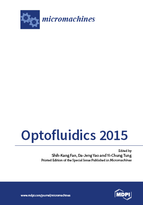Optofluidics 2015
A special issue of Micromachines (ISSN 2072-666X).
Deadline for manuscript submissions: closed (29 February 2016) | Viewed by 80364
Special Issue Editors
Interests: electrowetting; dielectrophoresis; electro-microfluidics; digital microfluidics; tissue engineering; optofluidics
Special Issues, Collections and Topics in MDPI journals
2. Department of Power Mechanical Engineering, National Tsing Hua University, Hsinchu 30013, Taiwan
3. Department of Engineering and System Science, National Tsing Hua University, Hsinchu 30013, Taiwan
Interests: digital microfluidics; intelligent gas sensing system; in vitro fertilization on a chip, and tera hertz system and its applications
Special Issues, Collections and Topics in MDPI journals
Interests: integrated biomedical microdevices; cell culture in various micro-environments; micro/nanofluidics; advanced micro/nano fabrication techniques
Special Issues, Collections and Topics in MDPI journals
Special Issue Information
Dear Colleagues,
Optofluidics combines and integrates optics and fluidics to produce versatile systems that are achievable only with difficulty through either field alone. With the spatial and temporal control of the microfluids, the optical properties can be varied, providing highly flexible, tunable, and reconfigurable optical systems. Since the emergence of optofluidics, numerous systems with varied configurations have been developed and applied to imaging, light routing, bio-sensors, energy, and other fields. This Special Issue aims to collect high quality research papers, short communications, and review articles that focus on optofluidics, micro/nano technology, and related multidisciplinary emerging fields. The special issue will also publish selected papers from the 5th Optofluidics 2015 conference (http://www.optofluidics2015.org/), 26–28 July 2015, Taipei, Taiwan. The aim of optofluidics 2015 conference is to provide a forum to promote scientific exchange and to foster closer networks and collaborative ties between leading international optics and micro/nanofluidics researchers across various disciplines. The scope of Optofluidics 2015 is deliberately broad and interdisciplinary, encompassing the latest advances and the most innovative developments in micro/nanoscale science and technology. Topics range from fundamental research to its applications in chemistry, physics, biology, materials and medicine. We are cordially inviting you to submit your manuscript to the Special Issue and also join us in Optofluidics 2015 conference to share the news in optics, fluidics, microsystems, and related emerging fields.
Prof. Dr. Shih-Kang Fan
Prof. Dr. Da-Jeng Yao
Prof. Dr. Yi-Chung Tung
Guest Editors
Manuscript Submission Information
Manuscripts should be submitted online at www.mdpi.com by registering and logging in to this website. Once you are registered, click here to go to the submission form. Manuscripts can be submitted until the deadline. All submissions that pass pre-check are peer-reviewed. Accepted papers will be published continuously in the journal (as soon as accepted) and will be listed together on the special issue website. Research articles, review articles as well as short communications are invited. For planned papers, a title and short abstract (about 100 words) can be sent to the Editorial Office for announcement on this website.
Submitted manuscripts should not have been published previously, nor be under consideration for publication elsewhere (except conference proceedings papers). All manuscripts are thoroughly refereed through a single-blind peer-review process. A guide for authors and other relevant information for submission of manuscripts is available on the Instructions for Authors page. Micromachines is an international peer-reviewed open access monthly journal published by MDPI.
Please visit the Instructions for Authors page before submitting a manuscript. The Article Processing Charge (APC) for publication in this open access journal is 2600 CHF (Swiss Francs). Submitted papers should be well formatted and use good English. Authors may use MDPI's English editing service prior to publication or during author revisions.
Keywords
- micro-/nano-fluidics;
- optical devices and systems;
- plasmonics and metamaterials;
- biochemical sensors and assays;
- optical imaging and light sources;
- fabrication and materials;
- energy and environment;
- optofluidic & 3D displays;
- droplets and emulsions








